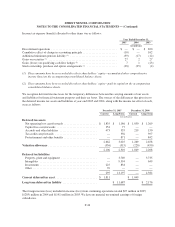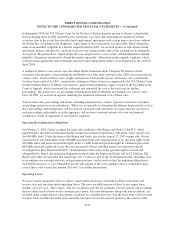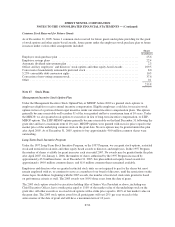Sprint - Nextel 2005 Annual Report Download - page 137
Download and view the complete annual report
Please find page 137 of the 2005 Sprint - Nextel annual report below. You can navigate through the pages in the report by either clicking on the pages listed below, or by using the keyword search tool below to find specific information within the annual report.SPRINT NEXTEL CORPORATION
NOTES TO THE CONSOLIDATED FINANCIAL STATEMENTS — (Continued)
Our foreign exchange risk management program focuses on reducing transaction exposure to optimize
consolidated cash flow. We enter into forward and option contracts in foreign currencies to reduce the impact of
changes in foreign exchange rates. Our primary transaction exposure results from net payments made to and
received from overseas telecommunications companies for completing international calls made by our domestic
customers and the operations of our international subsidiaries.
Interest Rate Swaps
As of December 31, 2005, we held fair value interest rate swaps with a notional value of $1 billion. These swaps
were entered into as hedges of the fair value of a portion of our senior notes. These interest rate swaps have
maturities ranging from 2008 to 2012. On a semiannual basis, we pay a floating rate of interest equal to the
six-month LIBOR plus a fixed spread and receive an average interest rate equal to the coupon rates stated on the
underlying senior notes. On December 31, 2005, the rate we would pay averaged 7.0% and the rate we would
receive was 7.2%.
Our interest rate swaps meet all the required criteria under SFAS No. 133, Accounting for Derivative Instruments
and Hedging Activities, as amended, in order to apply the shortcut method in accounting for these instruments.
Under the shortcut method we can assume that our interest rate swaps are perfectly effective in hedging our
interest rate risk. As a result, we recognize all changes in the fair values of these instruments in accumulated
other comprehensive loss on the Consolidated Balance Sheets, with no impact on earnings during the life of the
swap. We held only fair-value hedges during 2005 and 2004.
Our interest rate swap activity generated a net liability of $18 million at December 31, 2005 compared to a net
asset of $19 million as of December 31, 2004, resulting from changes in the fair value of the interest rate swaps.
As the swaps have been deemed perfectly effective, an offset was recorded to the underlying long-term debt.
During the fourth quarter 2005 we entered into a series of interest rate collars associated with the anticipated
issuance of debt by Local at the time of its expected spin-off in 2006. These collars have been designated as cash
flow hedges in Local’s standalone financial statements against the variability in interest payments that would
result from a change in interest rates before the debt is issued at the time of the spin-off. However, because the
forecasted interest payments of debt will occur after the subsidiary is spun-off, the derivative instruments do not
qualify for hedge accounting treatment in our consolidated financial statements, and so changes in the fair value
of these instruments are recognized in earnings during the period of change. During the fourth quarter 2005, the
fair value of these derivatives decreased, resulting in a pre-tax loss of $18 million as of December 31, 2005.
Stock Warrants
The stock warrants are not designated as hedging instruments and changes in the fair value of these derivative
instruments are recognized in earnings during the period of change. Our net derivative gains on stock warrants
were immaterial in all periods presented.
Equity Options
We have also entered into a series of option contracts associated with our investment in NII Holdings, Inc. The
first of these contracts was not designated as a hedging instrument, and changes in the fair value of the derivative
instrument are recognized in earnings during the period of change. The change in fair value of this instrument
resulted in a pre-tax loss of $9 million as of December 31, 2005. The remaining instruments are designated as
cash flow hedges and meet all the required criteria under SFAS No. 133 and the Derivative Implementation
Group Issue No. G-20, Assessing and Measuring the Effectiveness of a Purchased Option Used in a Cash Flow
Hedge, in order to assume that these option contracts are perfectly effective in hedging the market risk associated
with our investment in NII Holdings. As a result, we recognize all changes in the fair values of these remaining
F-42
























